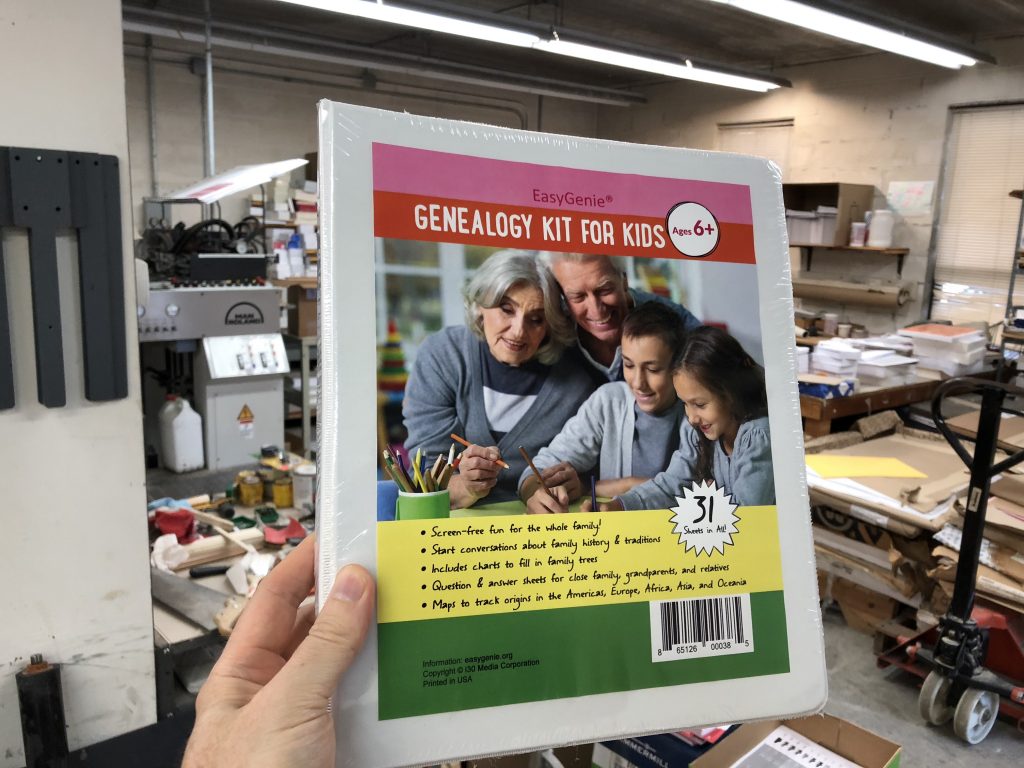As the owner of a small publishing company, I’m always on the lookout for new product or brand opportunities. The EasyGenie brand is in fact an offshoot of a book we published two years ago, Genealogy Basics In 30 Minutes. The author, Shannon Combs-Bennett, mentioned how paper genealogy forms can be a great tool for organizing and recording family data. I took that idea a step further, launching a package of high-quality genealogy forms for amateur researchers. It did extremely well, but it was just for adults. Today, I launched a new EasyGenie product, a genealogy kit for kids to enjoy. Here’s a shot of the first shrink-wrapped package coming off the printing press:
Designing this product was quite unlike the other EasyGenie packages I’ve released in the past. The obvious difference is it’s intended for kids, not adults. Earlier this year, I conducted a brief survey of the genealogy for kids marketplace and was surprised to see how limited the products were, not only in terms of the range of products available, but the quality of the materials. In many respects, they were scaled-down versions of genealogy paper forms for adults, printed on cheap copier paper.
I realized that there was an opportunity to provide something more dynamic, that was not only made better (all EasyGenie products use archival-quality paper, and larger formats are printed on an offset press in the United States) but was also made with kids in mind:
- The forms recognize kids’ natural curiosity and willingness to apply their own creativity
- They encourage discussions with adults, rather than on-screen research
- Explanatory annotations help guide them through concepts
- Recognition that kids have diverse backgrounds, including blended families and ancestry in multiple continents.
 This last point is driven home by recent government data on the nearly 74 million kids in the United States (“In 2016, 51 percent of U.S. children were White, non-Hispanic; 25 percent were Hispanic; 14 percent were Black, non-Hispanic; 5 percent were Asian, non-Hispanic; and 5 percent were non-Hispanic, All other races.”) So, the kids genealogy kit includes maps showing nearly every country and territory in the world, and encourages kids to decorate or annotate the maps with locations where their ancestors came from.
This last point is driven home by recent government data on the nearly 74 million kids in the United States (“In 2016, 51 percent of U.S. children were White, non-Hispanic; 25 percent were Hispanic; 14 percent were Black, non-Hispanic; 5 percent were Asian, non-Hispanic; and 5 percent were non-Hispanic, All other races.”) So, the kids genealogy kit includes maps showing nearly every country and territory in the world, and encourages kids to decorate or annotate the maps with locations where their ancestors came from.
As with many new design-oriented projects I am involved with these days, I used the Lean Media framework to develop ideas with members of the creative team (thank you Janice, Malgorzata, and Julie) and solicit feedback during the production process from potential customers and users. (Not the same! Parents are the customers, children are the users.)
One other big difference is the packaging. Kids are not the neatest and most organized people in the world (I say this as a parent), so this kit comes in a sturdy three-ring binder which not only makes it easier to store the contents, but also helps to preserve what’s inside.
I want this new EasyGenie product to succeed, but I also hope that it sparks interest in a rewarding hobby and helps children and their families preserve information for future generations.

